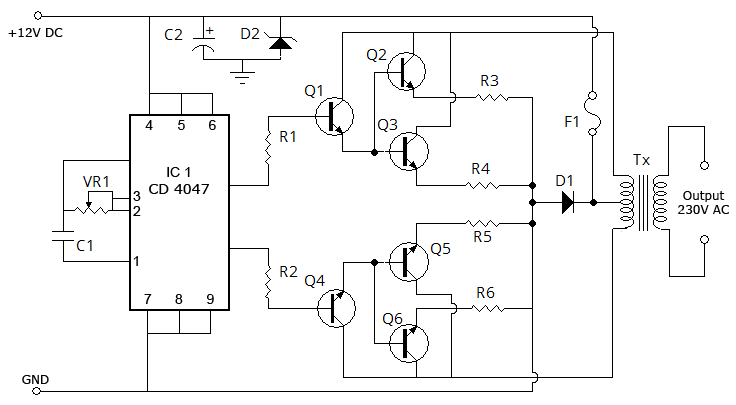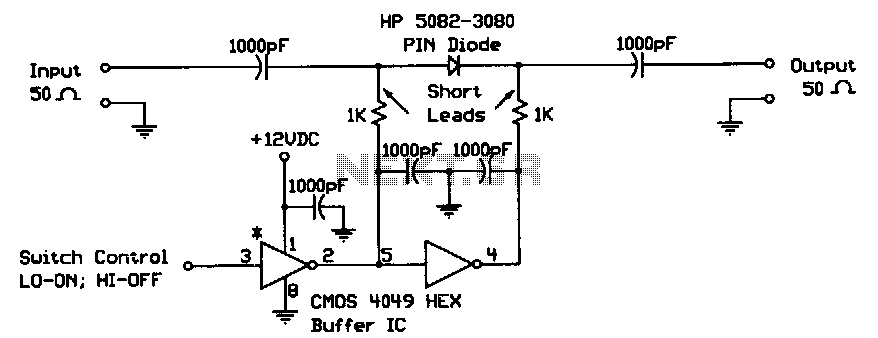
simple 100 watt inverter

This is the simplest circuit for a 100-watt inverter that generates 220V AC from 12V DC. It is considered simple because it utilizes a minimal number of components in its design, making it challenging to create a circuit with even fewer components. This 100W inverter circuit is effective for small loads such as a fan or 2-3 bulbs/lamps. In this circuit, a CD4047 integrated circuit (IC1) is employed to generate a 100Hz frequency that is 180 degrees out of phase. The CD4047 IC, produced by Texas Instruments, is primarily used as an astable or monostable signal generator. In this application, it operates as an astable multivibrator, with capacitor C1 connected between pins 1 and 3 of the CD4047. Variable resistor VR1 is utilized to adjust the frequency of the output signal. The circuit incorporates four 2N3055 transistors to amplify the pulse trains that are pre-amplified by two TIP122 transistors. Each half-cycle of the output uses three transistors: one TIP122 and two 2N3055 transistors to drive the output transformer (TX in the circuit). The maximum output power of the inverter is influenced by two primary factors: the maximum current rating of the transformer's primary winding and the current rating of the driver transistors. For the transformer, a 12V-0-12V, 10A step-down transformer should be used in reverse. This means the secondary winding (12V-0-12V) will serve as the primary, while the primary winding (220VAC side) will function as the secondary (output), effectively operating as a step-up transformer. A 5A transformer can also be used in place of the 10A transformer, but the output power will be reduced to 60 watts.
The circuit design for this 100-watt inverter is straightforward, relying on the astable multivibrator configuration of the CD4047 IC to produce a square wave signal. The frequency of 100Hz is suitable for driving the transformer, allowing the inverter to convert the low-voltage DC input into a usable AC output. The use of the CD4047 as a frequency generator is advantageous due to its reliability and ease of integration into the circuit.
The amplification stage, consisting of the TIP122 and 2N3055 transistors, is critical for ensuring that the output signal is strong enough to drive the transformer effectively. The TIP122, a Darlington pair transistor, provides high current gain, which is essential for driving the larger 2N3055 power transistors. The configuration of using two 2N3055 transistors in parallel for each half of the output cycle helps distribute the load and prevent overheating, thereby enhancing the overall efficiency and reliability of the inverter.
The choice of transformer is also crucial; using a 12V-0-12V transformer in reverse allows for a significant voltage increase, enabling the inverter to provide 220V AC output. The transformer must be rated appropriately to handle the desired output power without saturating. For applications requiring less power, a 5A transformer can suffice, but it is important to note that this will limit the inverter's output capacity to 60 watts.
Overall, this inverter circuit is an efficient solution for small power applications, providing a simple yet effective means of converting DC to AC power for various household devices.This is a simplest circuit for 100 watt inverter for generating 220vAC from 12vDC. I say simplest because here in this inverter circuit a minimum number of components are used to design the schematic, which is quite difficult to make a circuit like this with further fewer components. This 100W inverter circuit works great for small loads like a fa n or 2-3 bulbs/lamps. In this circuit as IC1 we used a CD 4047 IC to generate 100Hz frequency (180 degree out of phase). CD 4047 IC is from Texas Instruments. It is mostly used as Astable/Monostable signal generator device. In this circuit it is triggered as astable multivibrator by the capacitor C1 between the Pin 1 and 3 of CD4047. And VR1 is used to adjust the frequency of signal. Four 2N3055 transistors are used to amplify the pulse trains that are pre-amplified by two TIP122 transistors.
There used three transistors for each side (half cycle), one TIP122 & two 2N3055 transistor to drive the output transformer (TX in circuit). Four 2N3055 transistors are used as driving transistor. An inverters maximum output power depends on two factors; one is the max current rating of transformer`s primary winding and other factor is the current rating of driver transistors.
Transformer: Use a 12v-0-12v, 10A step-down transformer in reverse. That`s mean secondary winding (12v-0-12v) will be the primary and primary winding (220VAC side) will be the secondary (output). So that it will worked like a step-up transformer. You can also use a 5A transformer instead of 10A, if you couldn`t have 10A. But the output power will decrease to 60 Watt. 🔗 External reference
The circuit design for this 100-watt inverter is straightforward, relying on the astable multivibrator configuration of the CD4047 IC to produce a square wave signal. The frequency of 100Hz is suitable for driving the transformer, allowing the inverter to convert the low-voltage DC input into a usable AC output. The use of the CD4047 as a frequency generator is advantageous due to its reliability and ease of integration into the circuit.
The amplification stage, consisting of the TIP122 and 2N3055 transistors, is critical for ensuring that the output signal is strong enough to drive the transformer effectively. The TIP122, a Darlington pair transistor, provides high current gain, which is essential for driving the larger 2N3055 power transistors. The configuration of using two 2N3055 transistors in parallel for each half of the output cycle helps distribute the load and prevent overheating, thereby enhancing the overall efficiency and reliability of the inverter.
The choice of transformer is also crucial; using a 12V-0-12V transformer in reverse allows for a significant voltage increase, enabling the inverter to provide 220V AC output. The transformer must be rated appropriately to handle the desired output power without saturating. For applications requiring less power, a 5A transformer can suffice, but it is important to note that this will limit the inverter's output capacity to 60 watts.
Overall, this inverter circuit is an efficient solution for small power applications, providing a simple yet effective means of converting DC to AC power for various household devices.This is a simplest circuit for 100 watt inverter for generating 220vAC from 12vDC. I say simplest because here in this inverter circuit a minimum number of components are used to design the schematic, which is quite difficult to make a circuit like this with further fewer components. This 100W inverter circuit works great for small loads like a fa n or 2-3 bulbs/lamps. In this circuit as IC1 we used a CD 4047 IC to generate 100Hz frequency (180 degree out of phase). CD 4047 IC is from Texas Instruments. It is mostly used as Astable/Monostable signal generator device. In this circuit it is triggered as astable multivibrator by the capacitor C1 between the Pin 1 and 3 of CD4047. And VR1 is used to adjust the frequency of signal. Four 2N3055 transistors are used to amplify the pulse trains that are pre-amplified by two TIP122 transistors.
There used three transistors for each side (half cycle), one TIP122 & two 2N3055 transistor to drive the output transformer (TX in circuit). Four 2N3055 transistors are used as driving transistor. An inverters maximum output power depends on two factors; one is the max current rating of transformer`s primary winding and other factor is the current rating of driver transistors.
Transformer: Use a 12v-0-12v, 10A step-down transformer in reverse. That`s mean secondary winding (12v-0-12v) will be the primary and primary winding (220VAC side) will be the secondary (output). So that it will worked like a step-up transformer. You can also use a 5A transformer instead of 10A, if you couldn`t have 10A. But the output power will decrease to 60 Watt. 🔗 External reference





